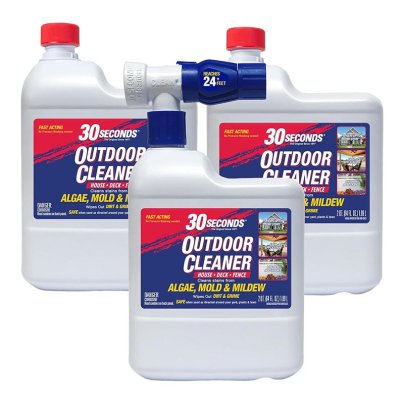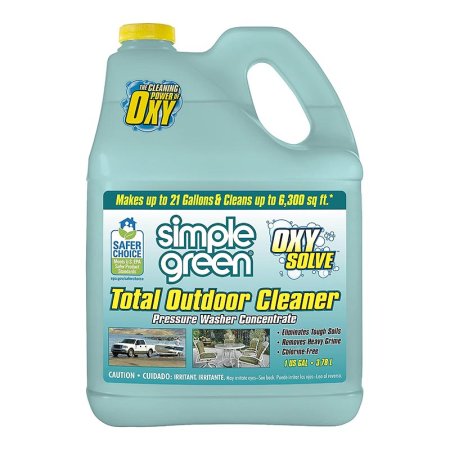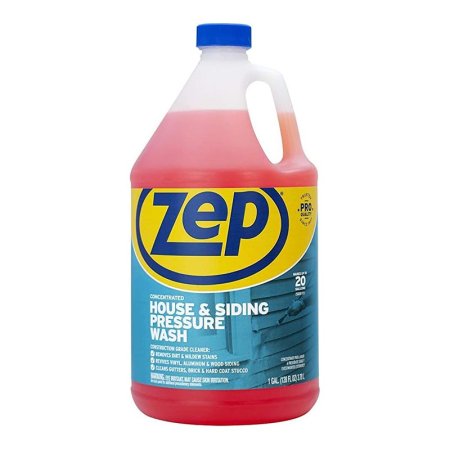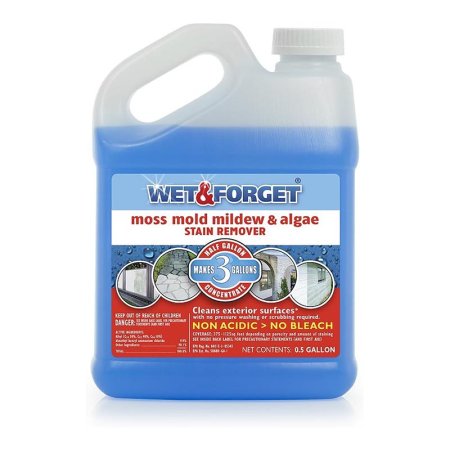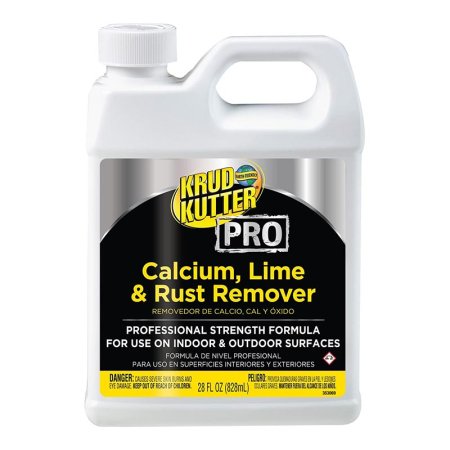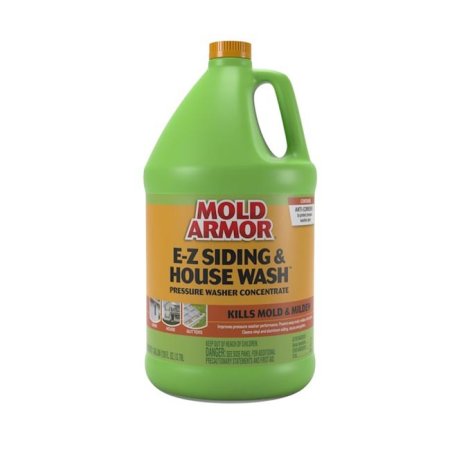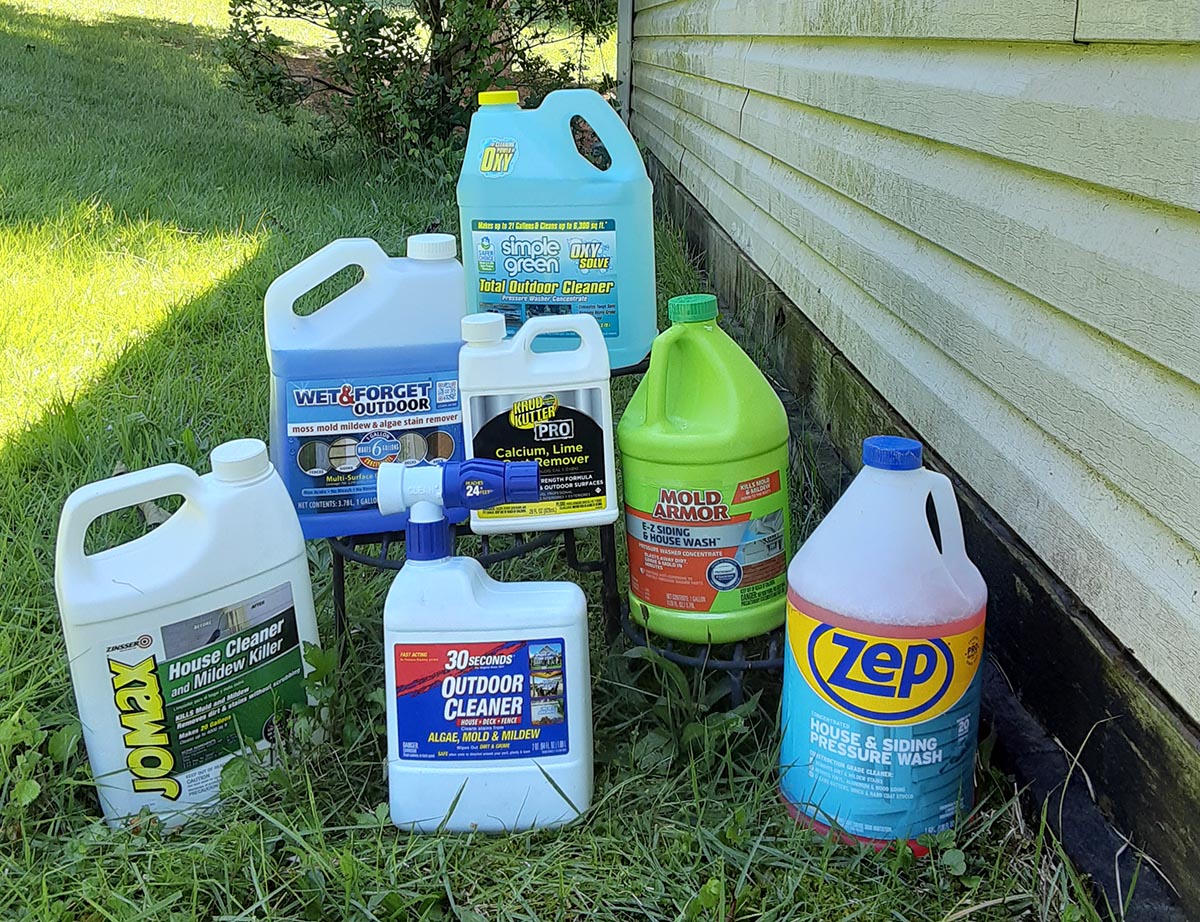
We may earn revenue from the products available on this page and participate in affiliate programs. Learn More ›
Vinyl siding is beloved for its low maintenance and affordable attractiveness. But over time, it can get dingy, hampering curb appeal and potentially causing damage over time. We recently tested seven vinyl siding cleaners that can tackle a variety of stains using manual, sprayer, and pressure washer applications.
Our favorite is the 30 Seconds Hose-End Sprayer Outdoor Cleaner because it delivers a sparkling clean with minimal time investment. This product only requires a hose, not a pressure washer, and comes with an adjustable spray applicator to reach the second story effectively.
Beautify and protect your home with an outdoor cleaner formulated to safely and effectively make vinyl siding look as good as new. Read on to learn what to look for while shopping and why the following stand out as the best vinyl siding cleaners available.
- BEST OVERALL: 30 Seconds Hose-End Sprayer Outdoor Cleaner
↓ Jump to Review - RUNNER-UP: Simply Green OxySolve Total Outdoor Cleaner
↓ Jump to Review - BEST BANG FOR THE BUCK: Zep House and Siding Pressure Wash
↓ Jump to Review - BEST FOR MILDEW: Wet & Forget Moss Mold Mildew & Algae Stain Remover
↓ Jump to Review - BEST FOR STAIN REMOVAL: Krud Kutter Pro Rust, Calcium & Lime Stain Remover
↓ Jump to Review - BEST FOR PRESSURE WASHER: Mold Armor E-Z Siding & House Wash
↓ Jump to Review - ALSO CONSIDER: Jomax House Cleaner and Mildew Remover
↓ Jump to Review
| Testing Stats | |
| Products tested | 7 |
| Time spent testing | 6 hours |
| Tests performed | 2 |
| Price range | $12 to $50 |
Our Top Picks
The following cleaners are suitable for various types of stain removal and can all help restore siding to a like-new appearance. The best vinyl siding cleaner must be safe for use on vinyl siding; effective at removing the type of stains in its category, like mold or tree sap; and provide clear application instructions and precautions (if necessary) to protect nearby people, animals, and plants.
Best Overall
30 Seconds Hose-End Sprayer Outdoor Cleaner
Product Specs
- Size: 2 quarts
- Treatment: Metal, plastic, cloth, painted surfaces, fiberglass, wood, composite, concrete, masonry, tile, asphalt
- Removal: Algae, mold, mildew, dirt
Our Ratings: Ease of Use 5/5; Effectiveness 5/5; Versatility 5/5; Value 5/5
What We Like
- Included applicator reaches second story
- Useful for a wide variety of surfaces
- Doesn’t require a pressure washer
- No scrubbing needed
What We Don’t Like
- Must have a hose that reaches the surface to be cleaned
Our top cleaner for vinyl siding, this pick from 30 Seconds comes in a 2-quart jug with an adjustable sprayer attached. It was easy to connect the sprayer to a standard garden hose and simply turn on the water—the sprayer directs a blast of water and diluted cleaner onto the siding to remove tough stains, grime, and dirt. We found that 30 Seconds began working on stains immediately. However, for the best results, saturate the surface to be cleaned using the sprayer/hose combination, let it remain for 10 minutes, and then rinse off. When used as directed, the product will not damage nearby plants.
Get the 30 Seconds vinyl siding cleaner at Amazon, Lowe’s, or The Home Depot.
Runner-Up
Simply Green OxySolve Total Outdoor Cleaner
Product Specs
- Size: 1 gallon
- Surfaces: Wood, plastic, metal, vinyl, concrete, wicker, asphalt, stone, fabric, brick
- Removal: Mold, mildew, moss, algae, dirt
Our Ratings: Ease of Use 5/5; Effectiveness 4.5/5; Versatility 5/5; Value 5/5
What We Like
- Safe for use around pets, plants, water sources
- Manual or pressure washer application options
- No scrubbing needed
- Useful on a wide variety of surfaces
What We Don’t Like
- Can damage oxidized paint, stained wood, and other surfaces
We love Simply Green OxySolve cleaner as an effective and environmentally friendly way to remove stains from siding. We appreciate that this formula is useful not just for vinyl siding but also for a variety of outdoor surfaces, including wood, plastic, metal, wicker, composite, and concrete. It does not cause any toxicity problems with water runoff and relies on peroxide, not bleach, as a brightener.
The product must be diluted with water for manual application, gently scrubbed with a soft bristle brush or sponge, and then rinsed with a garden hose. It can also be applied using the soap dispenser of a pressure washer, allowed to sit for 5 minutes, and then rinsed.
Get the Simply Green vinyl siding cleaner at Amazon, The Home Depot, or Walmart.
Best Bang for the Buck
Zep House & Siding Pressure Wash
Product Specs
- Size: 1 gallon
- Surfaces: Vinyl, wood, aluminum, fiber cement, stucco, brick
- Removal: Dirt, mildew
Our Ratings: Ease of Use 5/5; Effectiveness 4.5/5; Versatility 4/5; Value 4.5/5
What We Like
- Very affordable
- Light scent
- Can also be applied manually
What We Don’t Like
- Pressure washer use requires a downstream injector
Zep House and Siding pressure wash is an affordable option that comes in a 1-gallon jug of concentrated liquid that removes dirt and mildew. This solution can be used in a power washer with a downstream injector. We used the second option, diluting it in a bucket of water, applying it to vinyl siding with a soft nylon bristle brush, and then rinsing it with clean water. To keep nearby plants safe, spray them down with water before using Zep. It’s an affordable way to remove stains from vinyl siding and get it looking like new again.
Get the Zep vinyl siding cleaner at Amazon, Ace Hardware, or The Home Depot.
Best for Mildew
Wet & Forget Moss Mold Mildew & Algae Stain Remover
Product Specs
- Size: 1 gallon
- Surfaces: Vinyl, aluminum, wood, stucco, concrete, asphalt, fiberglass, brick, painted textured surfaces, stone, composite, canvas, clay, tile, cedar shake
- Removal: Moss, mold, mildew, algae
Our Ratings: Ease of Use 5/5; Effectiveness 5/5; Versatility 5/5; Value 4/5
What We Like
- No rinsing necessary
- Can be used manually with brush or sprayer; no pressure washer needed
- Good for a wide variety of surfaces
- Can store diluted cleaner to spot-clean as needed
What We Don’t Like
- Can’t apply on hot days or when rain is forecast
This bleach-free Wet & Forget formula harnesses the power of ammonium chloride to eliminate stains without harming nearby plants. This gentle formula does not require a pressure washer, scrubbing, or rinsing in order to work. We diluted 2.5 cups of the cleaning concentrate in 1 gallon of water and applied it manually. We let it work its deep-cleaning magic for 4 to 5 hours and then admired the sparkling results. Surfaces stay clean for up to a year.
Get the Wet & Forget vinyl siding cleaner at Amazon or Walmart.
Best for Stain Removal
Krud Kutter Pro Rust, Calcium & Lime Stain Remover
Product Specs
- Size: 28 ounces
- Surfaces: Vinyl, glass, plastic, stone, brick, porcelain, fiberglass, masonry, cement, aluminum
- Removal: Calcium, lime, rust
Our Ratings: Ease of Use 5/5; Effectiveness 3.5/5; Versatility 5/5; Value 4/5;
What We Like
- U.S. Environmental Protection Agency (EPA) Safer Choice certified
- Effective on rust stains
- Good for hard-to-reach spots
What We Don’t Like
- Needs scrubbing and possibly multiple applications
This pick from Krud Kutter is an affordable way to remove stains from vinyl siding and get it looking new again. The Krud Kutter solution can be used in a power washer or a hose-end dispenser (not included). It can also be diluted in a bucket of water, applied to vinyl siding with a soft nylon bristle brush, and then rinsed with clean water. To keep nearby plants safe, spray them down with water before and after using Krud Kutter. Nontoxic and bleach-free, this indoor-outdoor multipurpose cleaner uses ingredients like water and ammonium chloride to lift stubborn stains. We manually applied the ready-to-use cleaner undiluted and let it soak for a few minutes. Then, we scrubbed lightly with a soft-bristle brush and rinsed off with water.
Get the Krud Kutter vinyl siding cleaner at Amazon, Ace Hardware, or ODP Business Solutions.
Best for Pressure Washer
Mold Armor E-Z Siding & House Wash
Product Specs
- Size: 1 gallon
- Surfaces: Vinyl, aluminum, gutters, stucco, plastic, polyvinyl chloride (PVC)
- Removal: Mold, mildew, dirt
Our Ratings: Ease of Use 4/5; Effectiveness 4/5; Versatility 4/5; Value 5/5
What We Like
- Ready to use
- Contains an anticorrosive to protect pressure washer parts
- No scrubbing needed
What We Don’t Like
- Negatively affects glass if applied
For speedy cleaning, we recommend pressure-washing your house with Mold Armor E-Z cleaner. Mold Armor is an oxygenated bleach-based cleaner designed to remove mold and mildew from siding and discourage regrowth. For the best results, spray Mold Armor on vinyl siding, let it remain for 10 minutes, and then rinse off. We didn’t find that any scrubbing was necessary. We also found that, when used as directed, the product didn’t damage nearby plants.
Get the Mold Armor vinyl siding cleaner at Lowe’s, Ace Hardware, or Walmart.
Also Consider
Jomax House Cleaner and Mildew Remover
Product Specs
- Size: 1 gallon
- Surfaces: Vinyl, aluminum, wood, concrete, cement block; exterior painted nonporous surfaces
- Removal: Mold, mildew, dirt, stains
Our Ratings: Ease of Use 4/5; Effectiveness 4/5; Versatility 4/5; Value 3/5
What We Like
- Not harmful to nearby plants
- No pressure washer required
- No scrubbing needed
What We Don’t Like
- Unmanaged runoff can be detrimental to aquatic life
Jomax outdoor house cleaner contains powerful mildewcide for tackling tough mold buildup. We mixed the concentrated cleaner with both water and a small amount of household bleach and applied with a pump-type garden sprayer. We found this product to be effective with little or no scrubbing. We just sprayed the diluted cleaner on the vinyl siding, waited 10 minutes, and then rinsed the siding with clean water. We did a bit of scrubbing for especially tough stains. While the amount of added bleach is moderate (2.25 cups in 1 gallon of water), we followed the directions to spray nearby plants and foliage with water before and after cleaning the siding to protect them.
Get the Jomax vinyl siding cleaner at Amazon, Ace Hardware, The Home Depot, or Walmart.
Jump to Our Top Picks
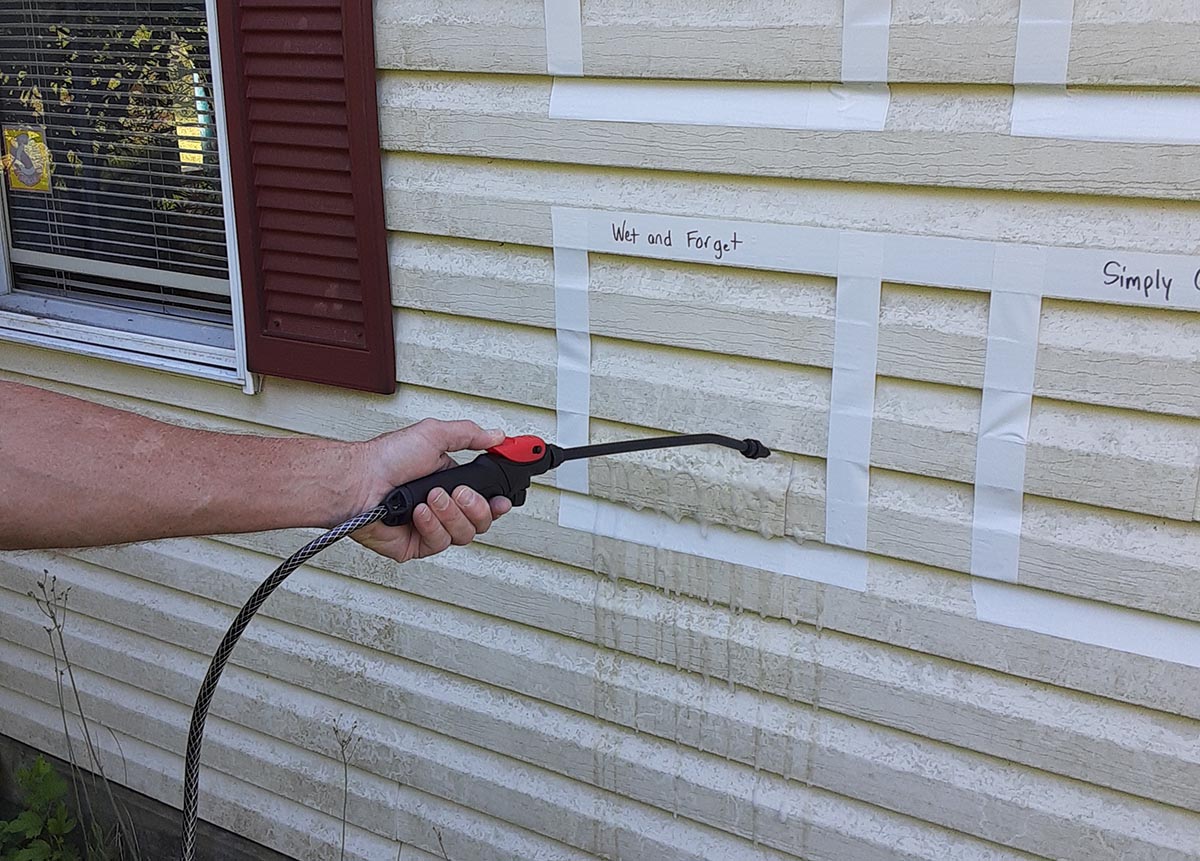
How We Tested the Best Vinyl Siding Cleaners
We tested seven cleaners on vinyl siding with similar degrees of staining. We followed dilution instructions and applied manually unless otherwise specified (sprayer, hose applicator, or pressure washer). Each product was tested on a 1-foot square, evaluating every 15 minutes after application and again after rinsing with a pressure washer. We also used a control square with no product applied that we evaluated after rinsing with water with a pressure washer. We conducted a similar test on a concrete walkway. Along with effectiveness, we evaluated cost, ease of application, additional supplies needed, ability to clean various surfaces and problems, timeliness, and environmental effects.
What to Consider When Choosing a Vinyl Siding Cleaner
Selecting the best cleaner for vinyl siding involves considering the type of stains you need to treat and identifying which application method best suits your house.
Ingredients
Some ingredients in house siding cleaners may react with the PVC that makes up vinyl siding. To avoid this, look for siding washes and multisurface outdoor cleaners with inorganic solvents, like water or hydrogen peroxide, or soaps containing water-soluble surfactants, like alkyl sulfates.
Cleaners with similar chemistry to vinyl siding—e.g., those containing organic solvents or petroleum ethers like acetone, benzene, or tetrahydrofuran—can damage it, creating dark and hazy patches, streaks, yellowing, and a brittle or distorted surface. Resist the temptation to spot clean vinyl siding with liquid grease removers, nail polish removers, and furniture polishes, which often contain organic solvents.
Mold and Mildew Removal
High moisture, a lack of sunlight, and exposure to dirt or tree sap can all cause mildew and mold to grow on vinyl siding. If your climate is damp, humid, or cloudy, or if you have a lot of vegetation or trees in the yard, consider a vinyl siding cleaner formulated to combat mildew and remove mold.
Mold removers often contain fungicides like ammonium chloride, chlorine bleach, or oxygenated bleach, which all mitigate mildew and mold and lift stubborn stains like rust or limescale. However, chlorine bleach can kill nearby plants, so products with oxygenated bleach (hydrogen peroxide) or ammonium chloride are safer for flowers, vegetables, and shrubs.
Application
Vinyl siding cleaner is commonly applied in three ways: via a pressure washer, through a hose attachment dispenser, or manually with a long-handled brush.
- Pressure-washing siding is the quickest and easiest method for cleaning exteriors and removing tough stains. A vinyl siding cleaner is specifically labeled for use with pressure washers and is usually sold in a large jug that can be poured into the pressure washer’s liquid reservoir.
- A hose-end dispenser works with a bottle that connects to the end of a standard garden hose. When the hose head is set to “on,” the spray cleaner will be diluted with water from the tap. This no-mess method eliminates the need to load any liquid into a separate device.
- Manual application involves pouring the contents into a bucket and applying it with a brush. Most cleaners designed for use with pressure washers can also be manually applied. Cleaners packaged in large resealable jugs work well with this type of application. For faster application over a large area, some can be mixed in a manual sprayer and then applied to the area.
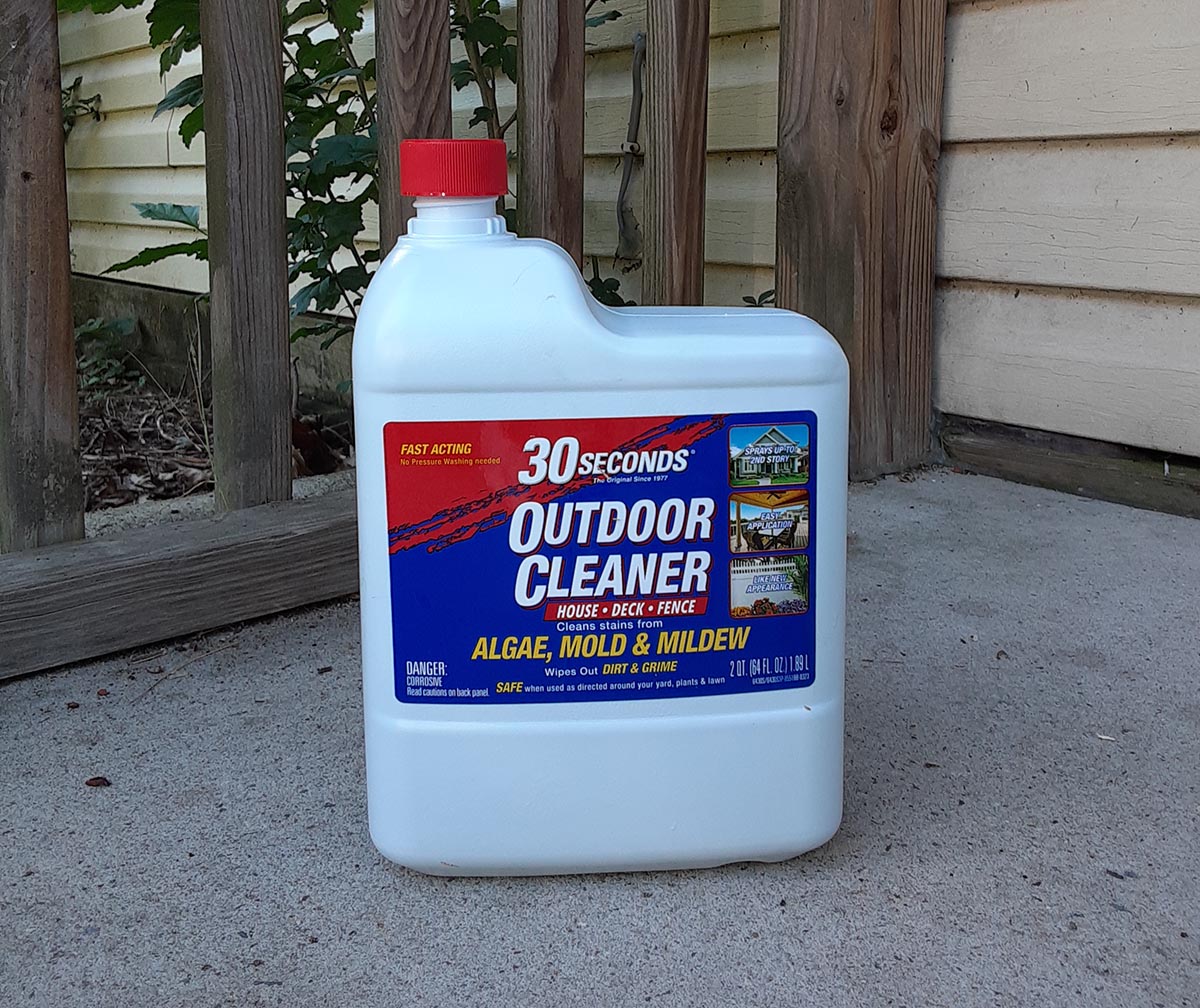
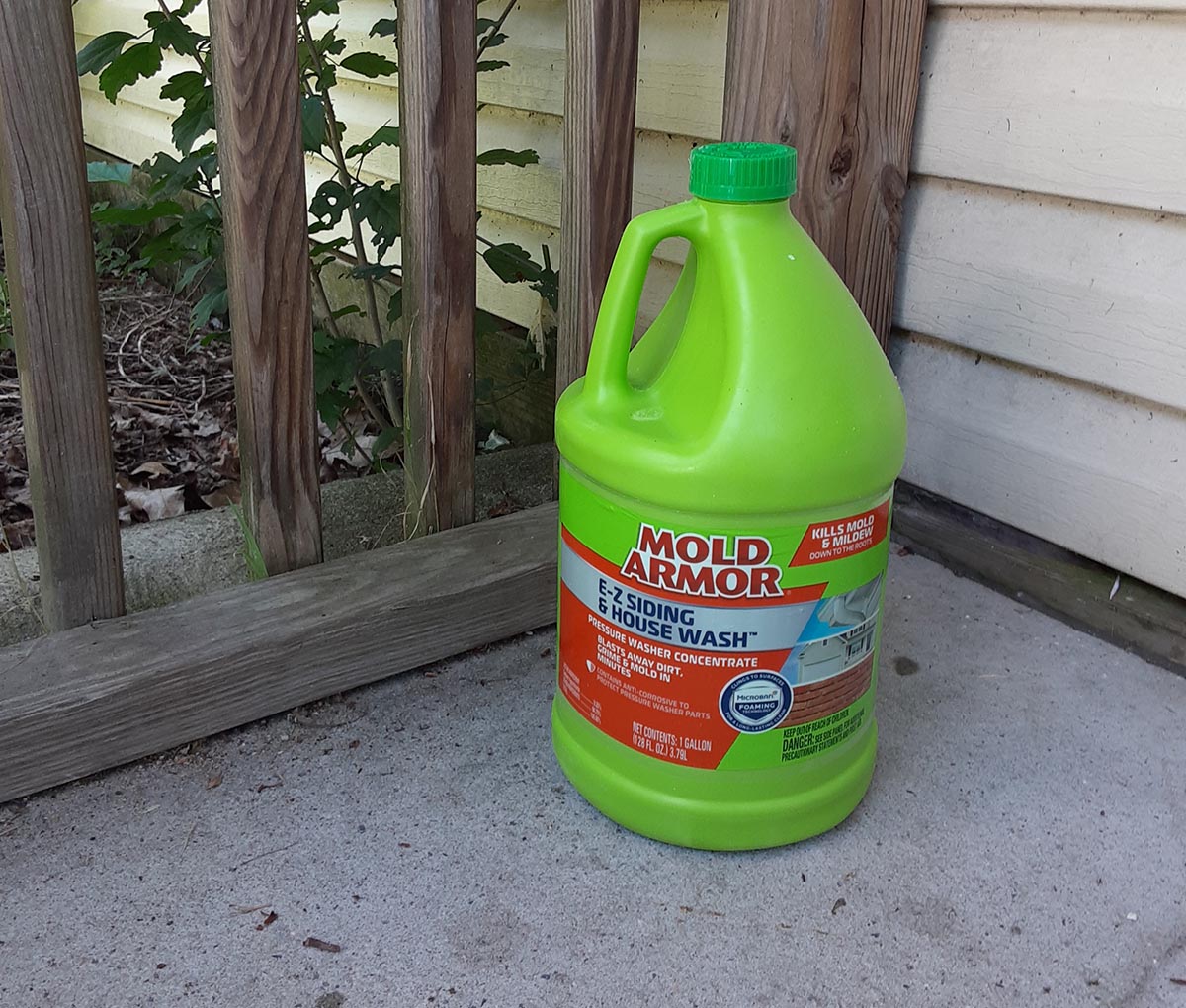
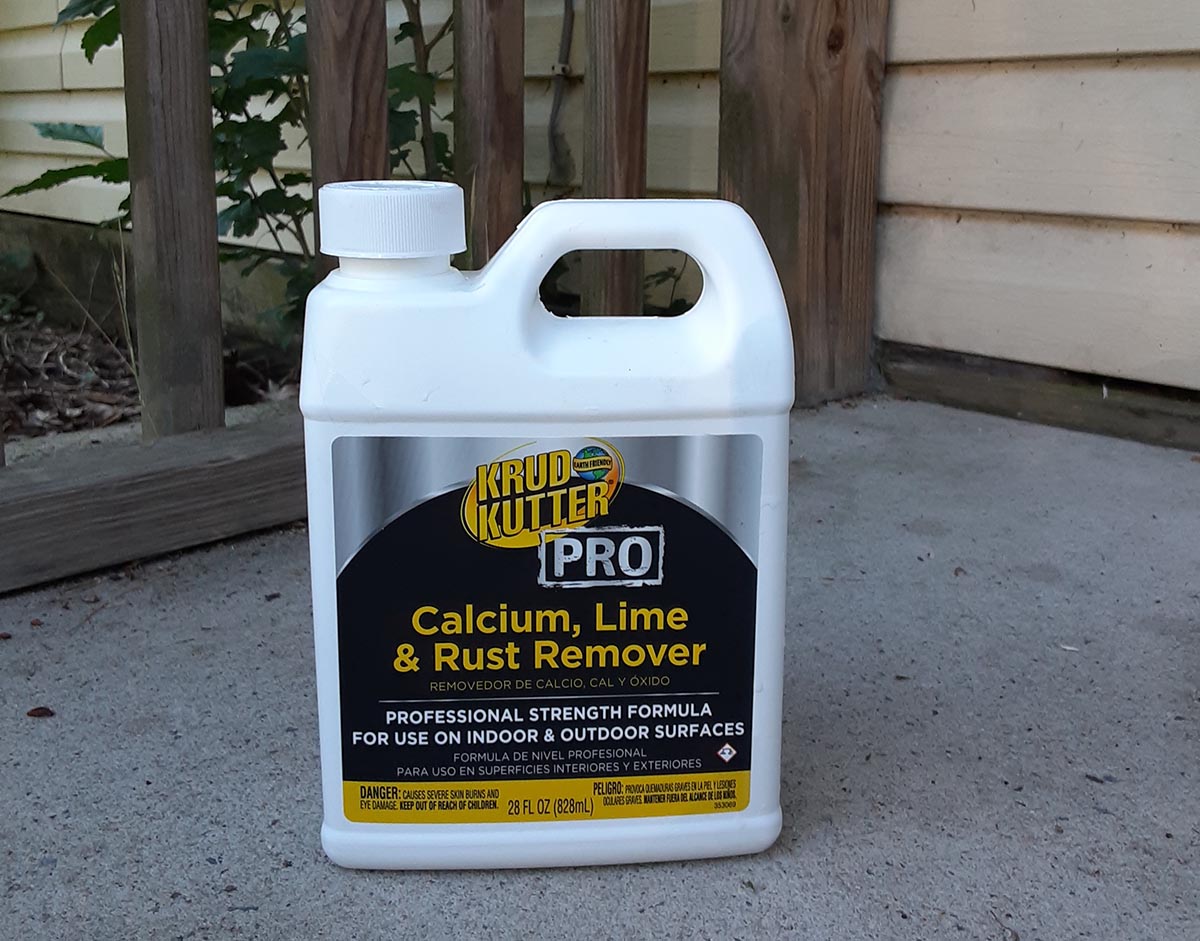
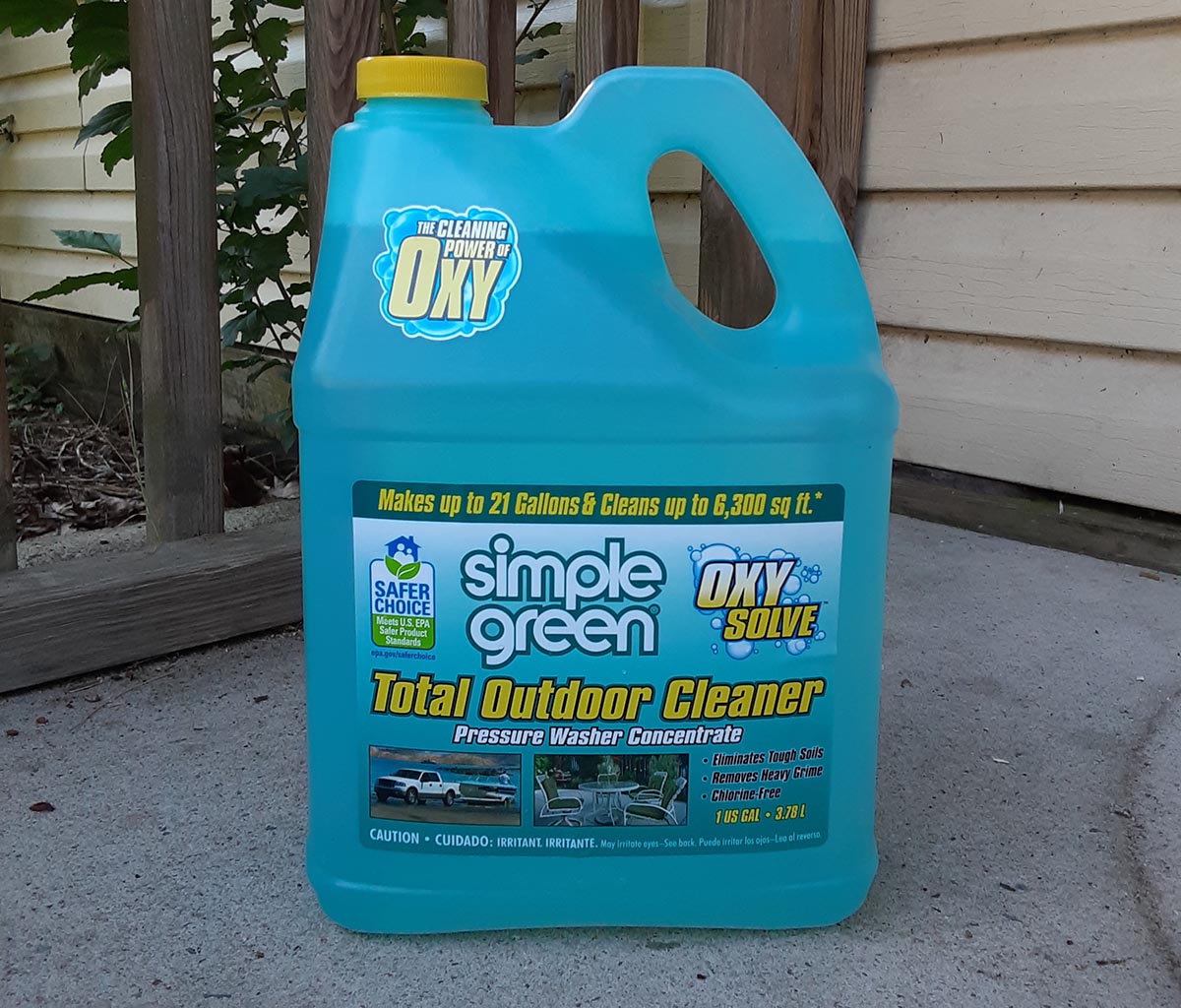
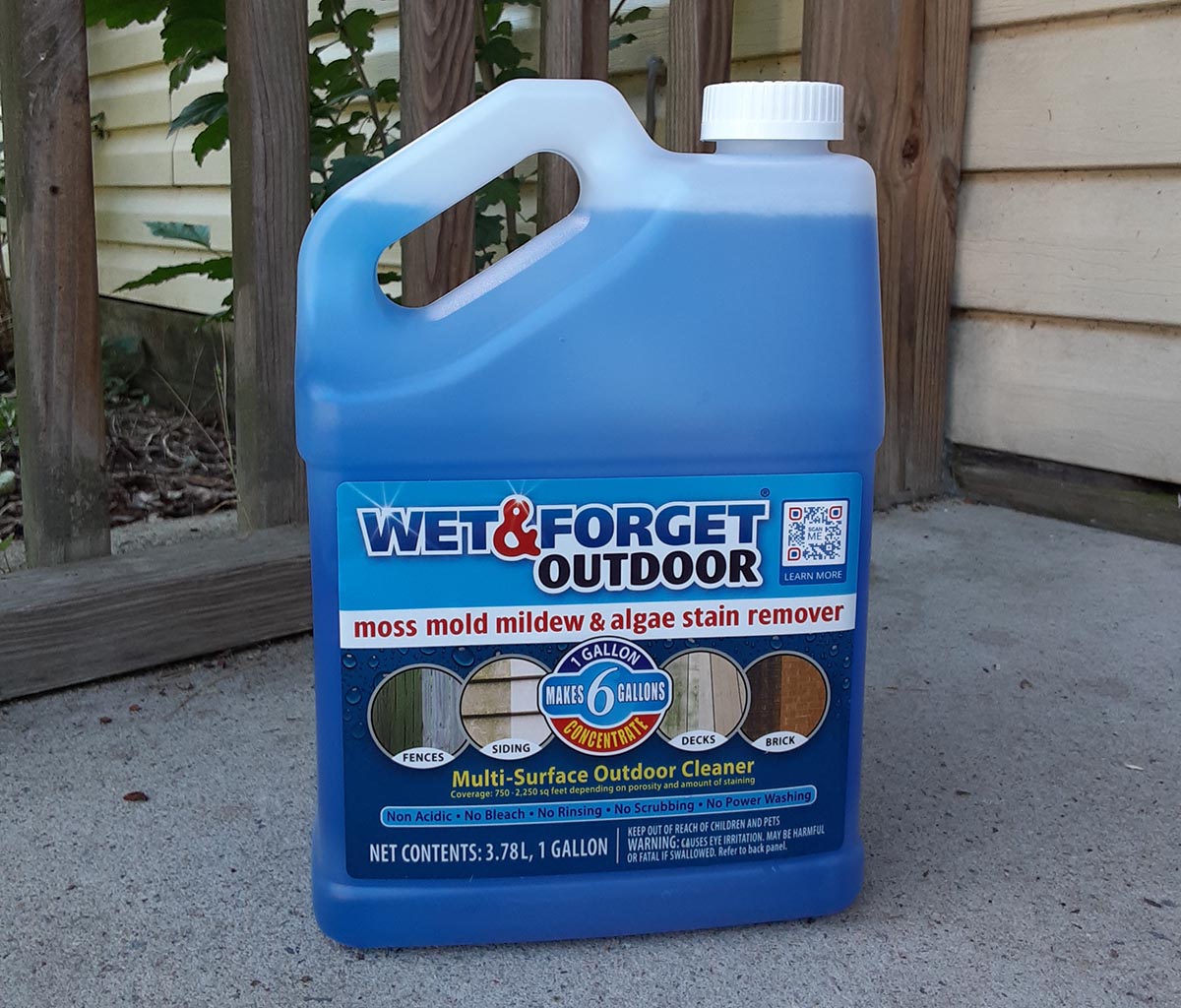
Formula
Vinyl siding cleaners are sold in both concentrated and ready-to-use formulas. Concentrated cleaners must be diluted in water before use. When using a concentrated cleaner with a pressure washer, the washer will automatically dilute the cleaner through a separate hose connection to the tap.
The same principle works with a hose-end dispenser: As the water passes through the dispenser, it dilutes the cleaner and emits a spray of cleaning solution on the siding. A concentrated formula is generally the more economical choice.
Environmental Impact
Cleaners that use inorganic solvents like benzene can wash down gutters and storm drains, polluting waterways and potentially impacting aquatic life. Vinyl siding cleaners labeled nontoxic and biodegradable can minimize the harmful effects of chemicals and be an eco-friendly way to clean siding.
To reduce environmental impact, select a siding cleaner that has the EPA Safer Choice label. This standard factors in carcinogenicity, reproductive/developmental toxicity, aquatic toxicity, and how long the cleaner stays in the environment before breaking down.
FAQs
While vinyl siding is low maintenance, it can become stained like any other siding. Refreshing siding is a simple process that often involves spraying on a suitable cleaner and then rinsing it off. For those new to cleaning vinyl siding, a few questions are to be expected.
The fastest way to clean exterior siding is with a power washer, but it isn’t essential. Many vinyl siding products come in hose-end jugs that spray diluted cleaner right from the hose. Some can be applied using a manual sprayer, and others are diluted in a bucket of water and applied with a soft nylon brush. All three methods work equally well and can hold their own against power washing, so choose the method that works best for your situation.
Yes, but use the lowest setting on the pressure washer. To prevent spray from getting under the siding, don’t direct the spray upward. It is also best to avoid spraying directly into the seams at corners or around doors or windows.
Pressure washers have their dos and don’ts, and if they aren’t a good fit for you, other methods can be just as effective. Add concentrated siding cleaner to a hose-end dispenser and attach a garden hose to the washer. Alternatively, dilute the cleaner in a large bucket of water and use a soft nylon brush to clean the siding. You can also dilute some cleaners in a sprayer and apply with the manual sprayer. In all cases, rinse the siding with clear water after cleaning.
It’s important to pay attention to ingredients when cleaning vinyl siding. A variety of products, including furniture cleaners, liquid grease removers, nail polish, undiluted chlorine bleach, or other cleaners containing organic solvents, can damage vinyl siding. Also, since abrasive products like steel wool or scrubbers can cause damage, it’s best to avoid them.
For most homes, an annual spring cleaning is sufficient. Homes in more humid areas that encourage mold and mildew growth may need more frequent cleaning. You can also spot-clean small sections of mold or mildew growth as you notice them.
Meet the Tester
Jodi Webb is a longtime resident of a vinyl-sided home and is constantly looking for ways to spruce it up after a long, snowy winter. A DIY-er married to a contractor, Jodi has written on a variety of topics for Bobvila.com, including pressure washers, composite decking, and soaking tubs.
Additional research provided by Glenda Taylor and Manasa Reddigari.
